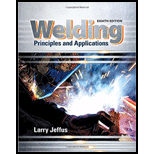
Bundle: Welding: Principles and Applications, 8th + MindTap Welding, 4 terms (24 months) Printed Access Card
8th Edition
ISBN: 9781337219426
Author: Larry Jeffus
Publisher: Cengage Learning
expand_more
expand_more
format_list_bulleted
Textbook Question
Chapter 6, Problem 8R
What are the best ways to remove slag between filler weld passes?
Expert Solution & Answer
Want to see the full answer?
Check out a sample textbook solution
Students have asked these similar questions
please help me solve this equation
I need expert handwritten solutions to this question, don't use Ai
please help solve us Pcr=pi^2EI/KL^2 formula and SF formula
Chapter 6 Solutions
Bundle: Welding: Principles and Applications, 8th + MindTap Welding, 4 terms (24 months) Printed Access Card
Ch. 6 - What is the first weld bead of a multiple pass...Ch. 6 - What is the purpose of using ceramic backup tapes...Ch. 6 - How can discontinuities in the root face be...Ch. 6 - Describe the motion of the electrode in keyhole...Ch. 6 - What is the purpose of placing an assembled test...Ch. 6 - If the key hole becomes smaller and smaller, what...Ch. 6 - What is the purpose of a hot pass?Ch. 6 - What are the best ways to remove slag between...Ch. 6 - What is the last weld bead on a multipass weld...Ch. 6 - What is the purpose of grooving a joint before...
Ch. 6 - After a weld is back gouged and a groove is...Ch. 6 - When stopping an SMA welding bead on a pipe, what...Ch. 6 - What is the purpose of preheating metal before it...Ch. 6 - What is the purpose of postheating the metal after...Ch. 6 - What is interpass temperature?Ch. 6 - The AWS Visual Inspection Criteria allows one...Ch. 6 - What is the difference between a transverse face...Ch. 6 - What changes can be made to successfully make a...
Knowledge Booster
Learn more about
Need a deep-dive on the concept behind this application? Look no further. Learn more about this topic, mechanical-engineering and related others by exploring similar questions and additional content below.Similar questions
- I need expert handwritten solutions, don't use Artificial intelligencearrow_forwardConsider the combined gas-steam power cycle. The topping cycle is a gas-turbine cycle that has a pressure ratio of 8. Air enters the compressor at 300 K and the turbine at 1300 K. The isentropic efficiency of the compressor is 80%, and that of the gas turbine is 85%. The bottoming cycle is a simple Rankine cycle operating between the pressure limits of 7 MPa and 5 kPa. Steam is heated in a heat exchanger by the exhaust gases to a temperature of 500°C and the isentropic efficiency of the turbine is 90 %. The exhaust gases leave the heat exchanger at 450 K. Considering the mass flow rate steam as 1 kg/s, determine: A) Net power, B) Total input heat, C) Total entropy generation, D) Energy efficiency, E) Exergy efficiency, F) T-s diagram Solve by EES Compressor Air -③ in Exhaust gases Pump Combustion chamber Gas turbine Gas cycle Heat exchanger Condenser Steam Steam turbine cyclearrow_forwardI need expert solution s to this question, don't use Artificial intelligencearrow_forward
- I need solutions to this questions Don't use Artificial intelligencearrow_forwardPlease consider the following closed-loop Multiple-Input Multiple-Output (MIMO) control system: R₁(s) and R2(s) are the reference signals (or inputs), • G₁(s) (where i = 1,2,3,4,5) are the plant transfer functions, • C₁(s) and C2(s) are the responses (or system outputs), • All of them are in Laplace domain. R2 + R₁ + + G₂(s) G3(S) Tasks: G5(s) G4(s) + G₁(s) می a) Please derive the transfer function between C₁ (s) and R₂(s) (i.e., find R₂(s) (10 marks) (10 marks) b) Please derive the transfer function between C₂(s) and R₁(s) (i.e., find C2 (s)). R₁(s) Hint: Please carefully analyse how the signals interact with the plants G₁(s) and find all paths fromarrow_forwardMột thanh dài L = 2,5 m được nối bằng chốt với một con lăn ở A. Con lăn chuyển động dọc theo một đường ray nằm ngang như hình vẽ với VA 5 m/s. Xác định vận tốc của điểm C (trung điểm của thanh AB) = tại thời điểm 0 = 33° và O = 0.4 rad/s. A. v = (-5.42+0.272})(m/s) C. v = (5.421+0.272})(m/s) B. v =(0.272i+5.42j)(ms) D. (5.42-0.272)(m/s) = C Barrow_forward
- The simulink and Matlab part are the prioritized areas please.arrow_forwardPlease do not rely too much on chatgpt, because its answer may be wrong. Please consider it carefully and give your own answer. You can borrow ideas from gpt, but please do not believe its answer.Very very grateful! Please do not copy other's work,i will be very very grateful!!arrow_forwardAn industrial burner uses natural gas as fuel. The natural gas consists primarily of CH4 with small quantities of several other light hydrocarbons and can be represented as C1.16H4.32 To achieve low emissions of oxides of nitrogen, the burner operates lean at equivalence ratio of 0.4. Assume complete combustion and answer the following questions. i) What is the operating air-fuel ratio (i.e. mass air/mass of fuel)? [6 marks] ii) What is the percent excess air in the combustion products? [3 marks] iii) What is the oxygen (O2) mole fraction in the combustion products? [6 marks]arrow_forward
arrow_back_ios
SEE MORE QUESTIONS
arrow_forward_ios
Recommended textbooks for you
 Welding: Principles and Applications (MindTap Cou...Mechanical EngineeringISBN:9781305494695Author:Larry JeffusPublisher:Cengage Learning
Welding: Principles and Applications (MindTap Cou...Mechanical EngineeringISBN:9781305494695Author:Larry JeffusPublisher:Cengage Learning

Welding: Principles and Applications (MindTap Cou...
Mechanical Engineering
ISBN:9781305494695
Author:Larry Jeffus
Publisher:Cengage Learning
Differences between Temporary Joining and Permanent Joining.; Author: Academic Gain Tutorials;https://www.youtube.com/watch?v=PTr8QZhgXyg;License: Standard Youtube License